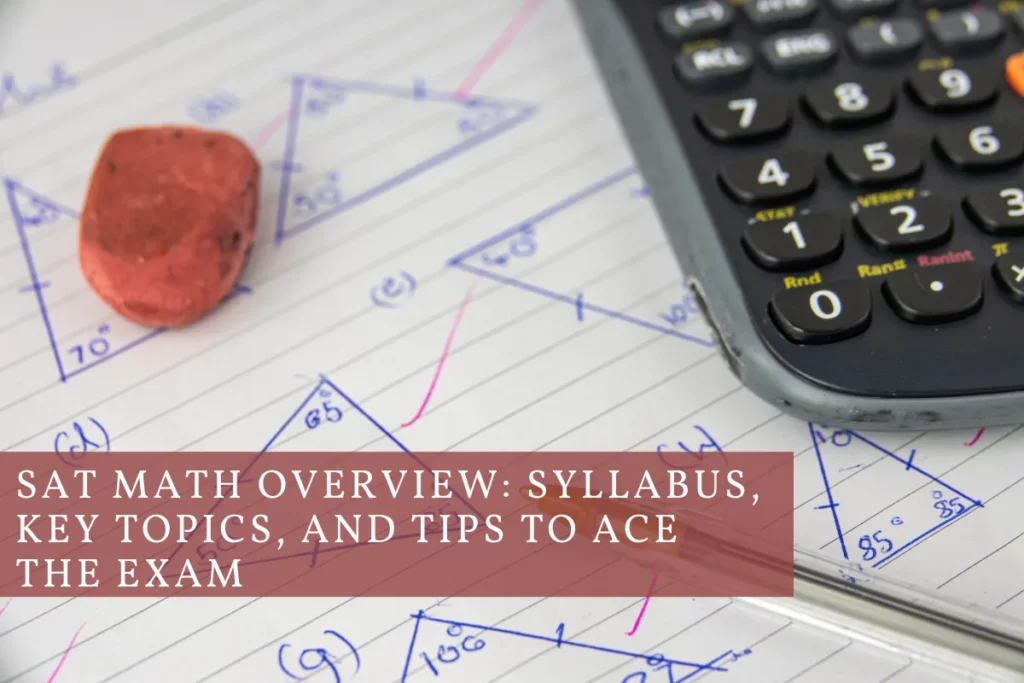The SAT Math section is one of the most critical components of the SAT exam, contributing 50% of your total score. With over 1.5 million students taking the SAT each year, performing well in Math can be a game-changer for admission to top universities worldwide (College Board, 2024). Many students find themselves struggling with unfamiliar question formats and time constraints, which can significantly impact their scores.
The problem is that without a structured approach, students often spend months preparing inefficiently, only to face confusion on test day. The good news? With a focused strategy, practice, and the right guidance, mastering SAT Math is achievable. This guide provides a comprehensive breakdown of the SAT Math syllabus, question types, preparation strategies, and resources to help you maximise your score.
What is SAT Math?
SAT Math evaluates your mathematical knowledge, problem-solving skills, and quantitative reasoning. The section is designed to test not only your ability to solve equations but also your skill in interpreting real-world problems using mathematical concepts.
The SAT Math section is divided into two parts:
- Calculator-allowed section
- No-calculator section
Together, they assess your skills across algebra, geometry, trigonometry, statistics, and advanced math topics. Excelling in SAT Math is essential, especially if you are targeting competitive programs in the USA, UK, or Canada.
Key Takeaways:
- Contributes 50% of the total SAT score (200-800 points)
- Tests problem-solving and analytical reasoning
- Covers topics from algebra to trigonometry
- Offers digital and paper-based formats
SAT Math Test Format & Pattern for Indian Students
Understanding the test structure is crucial before you start preparing. The SAT Math section is two-staged and timed separately.
| Parameter | Details |
|---|---|
| Modules | Two: 1 no-calculator, 1 calculator-allowed |
| Questions per Module | 20 operational + 2 pretest questions |
| Total Questions | 44 |
| Duration | 70 minutes (35 minutes each module) |
| Question Types | 75% multiple choice, 25% student-produced responses |
| Scoring | 200–800 points |
The digital SAT Math format introduces adaptive testing elements, where the second module may adjust in difficulty based on your first module performance. This affects scoring and strategic approaches during practice tests.
SAT Math Syllabus & Topics Covered
The SAT Math section evaluates skills across five core areas. Questions range from basic algebra to complex problem-solving, often presented in real-world contexts.

1. Algebra (35%)
Algebra forms the foundation for mathematics and focuses on solving equations, inequalities, and understanding functions.
- Solving Equations: Learn to solve linear equations or unknown variables in simple linear equations, such as ax+b=0 and multi-step expressions.
- Linear Inequalities: Solve and graph inequalities such as 2x+3 > 5 and graph their solutions on number lines.
- Interpreting Linear Functions: Understand slopes, intercepts, and relationships in equations like y=mx+c.
Algebra helps you model real-world problems, like budgeting or predicting outcomes.
2. Problem Solving & Data Analysis (15%)
This section tests your ability to interpret data, ratios, and percentages.
- Ratios and Proportions: Apply ratios to solve real-life problems, like scaling recipes or calculating efficiency.
- Percentages: Practice calculating percentage changes, discounts, and proportions.
- Interpreting Data: Extract information, identify trends, and draw conclusions from graphs, charts, and tables.
Mastering this sharpens your analytical skills for everyday decision-making.
3. Advanced Math (35%)
Advanced Math builds on algebra with more complex topics like non-linear equations and number systems.
- Quadratic Equations: Solve equations like ax² + bx + c=0 using formulas or factorisation.
- Radicals: Work with square roots (√ 25) and simplify root expressions.
- Complex Numbers: You’ll explore numbers that include iii, the imaginary unit, where i2 = −1, and learn how to perform operations involving these numbers.
These concepts are essential for tackling higher-level problems in science and engineering.
4. Geometry (15%)
Geometry focuses on shapes, spatial reasoning, and properties of figures.
- Shapes and Properties: Study angles, lines, circles, and polygons to solve problems like calculating triangle angles.
- Volume and Area: Calculate areas and volumes of 3D shapes, such as spheres and cylinders.
- Trigonometry: Use sine, cosine, and tangent to solve triangle relationships.
Geometry has practical uses in fields like architecture and navigation.
5. Statistics & Probability (15%)
This section introduces data analysis, averages, and probability.
- Averages: Calculate means, medians, and modes to summarise data.
- Probability: Understand the likelihood of events, from simple coin flips to more complex scenarios.
- Data Interpretation: Organise and analyse data using graphs and charts for informed decision-making.
These skills are widely applied in areas like medicine, economics, and sports analytics.
Below is a table in digital SAT format highlighting the subject areas, weightage, and skills or topics tested.
SAT Math Topics, Subtopics, and Weightage
| Math Topic | Subtopics | Weightage |
|---|---|---|
| Algebra | Linear equations, inequalities, functions, systems | 35% |
| Advanced Math | Quadratic equations, radicals, polynomials, and non-linear functions | 35% |
| Problem Solving & Data Analysis | Ratios, rates, percentages, probability, statistics | 15% |
| Geometry & Trigonometry | Triangles, circles, area, volume, trigonometry | 15% |
This table provides a concise overview of the distribution of questions across topics, helping you prioritise areas for focused practice.
Is SAT Math Easy or Hard?
The difficulty of SAT Math is moderate to high. Around 30% of questions are word problems set in real-world contexts, which often challenge students more than computation-based questions. Adaptive testing in the digital SAT may make some questions more difficult depending on your performance in earlier modules.
Tips to Handle Difficulty:
- Focus on conceptual clarity rather than memorisation
- Use shortcuts and formulas efficiently
- Time management is key; do not get stuck on one question
How to Improve Your SAT Math Score: Preparation Tips for Indian Students
Did you know that around 30% of SAT Math questions are “word” problems set in real-world contexts? These questions test not only your math skills but also your ability to interpret scenarios from science, social studies, or everyday life.
To improve your SAT Math score, focused preparation, regular practice, and effective strategies are key. Here are some tips to help you excel.

- Master the Basics: Make sure you have a solid understanding of basic mathematical concepts before moving on to advanced topics.
- Practice Regularly: Consistent practice is key. Take SAT math practice tests to get used to the types of questions and the test format.
- Focus on Weak Areas: Identify the topics where you struggle the most and dedicate extra time to mastering them.
- Use SAT Math Resources: Study guides, online courses, and practice books can be incredibly helpful.
SAT Math Score & University Benchmarks for Indian Students
Your SAT Math score is a key factor in meeting these expectations. Below is a table showing popular universities that accept SAT scores and their average score requirements.
| Raw Score | Scaled Score | % Correct |
|---|---|---|
| 54 | 790–800 | 100% |
| 50 | 750–780 | 93% |
| 45 | 670–700 | 83% |
Top University Benchmarks
| Country | Top Universities | Average SAT Math Score |
|---|---|---|
| USA | Harvard University | 1500+ |
| USA | Stanford University | 1500–1560 |
| UK | University College London (UCL) | 1300+ |
| Canada | University of British Columbia | 1250–1420 |
| Australia | University of Melbourne | 1200+ |
Recommended Books & Resources
- College Board Official SAT Study Guide
- PWN the SAT: Math Guide by Mike McClenathan
- Barron’s SAT Math Workbook
- Dr. John Chung’s SAT Math
- Kaplan SAT Prep
- Online: LeapScholar SAT Math prep
LeapScholar SAT Math Support for Indian Students
LeapScholar provides personalised SAT Math preparation:
- 1:1 Live Classes: Customised tutoring for your weak areas
- 100+ Mock Tests: Digital and paper-based simulations
- Detailed Feedback: Identify strengths and weaknesses
- Flexible Schedule: 3–8 week programs based on your availability
Struggling with SAT Math? Join LeapScholar’s Free Masterclass today and learn expert strategies to achieve a 1500+ SAT score!
Conclusion
The SAT Math section plays a pivotal role in your overall SAT performance. With a structured preparation plan, regular practice, and the right resources, you can significantly improve your score.
LeapScholar offers personalised SAT Math support, expert tutors, and digital mock tests to help you maximise your potential. Start your SAT Math prep today with LeapScholar and take the first step toward achieving your dream SAT score!
Frequently Asked Questions (FAQs)
-
What kind of math is on the SAT?
SAT Math tests algebra, advanced math, problem-solving & data analysis, geometry, and trigonometry. Questions include equations, functions, statistics, and real-world word problems.
-
Is SAT maths difficult?
Difficulty varies. About 30% of questions are word problems, and adaptive testing may adjust difficulty. With proper preparation and practice, it is manageable.
-
Is a 470 on SAT math good?
A score of 470 is below average, as the Math section ranges from 200–800. Most top universities expect 700+ in Math. It indicates areas to improve before attempting the test again.
-
How rare is an 800 SAT math?
Scoring 800 is extremely rare; less than 1% of test-takers achieve a perfect score. It requires strong conceptual understanding, speed, and accuracy.
-
What is SAT for Indian students?
For Indian students, the SAT is a standardized exam used for US and other international college admissions. It assesses math, reading, and writing skills and helps universities compare applicants globally.
-
What is meant in SAT math?
SAT Math refers to the mathematical portion of the SAT exam. It evaluates quantitative reasoning, problem-solving abilities, and knowledge of algebra, geometry, trigonometry, and data analysis.


















Have Questions? Get Guidance to reach your Dream University
Connect with India's finest counsellors and biggest study abroad community.
Get Guidance